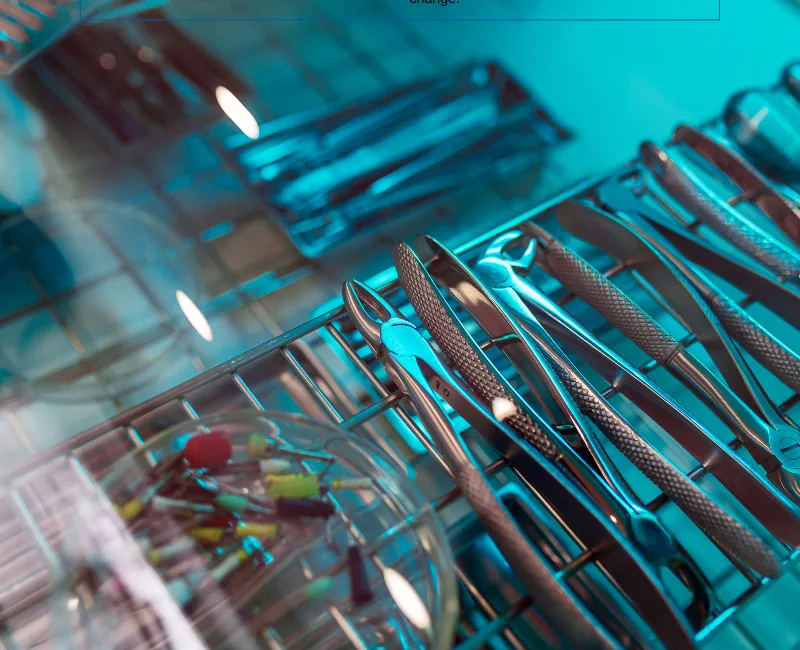Medical device sterilization is essential to maintain the safety of patients and healthcare professionals. Improperly sterilized medical devices can produce dangerous bacteria, viruses, and other pathogens that can cause infections and other serious health issues. It is important that medical device manufacturers establish an effective sterilization process and aseptic techniques for all medical devices.
Heat, radiation, and chemical processes can all be used to sterilize the medical device. The ideal approach to adopt the sterilization technique will depend on the type of medical device, the materials to be utilised, and the device’s intended usage. Each method has benefits and drawbacks.
When selecting a sterilization technique for medical devices, there are several factors to take into account . These include:
- Device type: The type of medical device being sterilized is an important consideration. Some devices can require specialized tools or processes, while others might be susceptible to specific kinds of sterilizing techniques.
- Material composition: The choice of a sterilizing technique may impact by the medical device’s material composition. Some sterilization techniques, such as heat sterilization, can harm some materials, like rubber or plastic. Heat-sensitive materials may require a low-temperature sterilization technique, such as Ethylene oxide or Hydrogen Peroxide sterilization.
- Packaging materials: Packaging materials play a crucial role in the selection of sterilization methods. The packaging material must be compatible with the sterilization method and must maintain the sterility of the device until it is used by the end user.
The Tyvek, and plastic film packaging materials can be sterilized by ethylene oxide or gamma radiation while Polyethylene packaging material can be sterilized using steam or dry heat, Aluminum foil, and glass packaging materials can be sterilized using heat, and Paper as can be sterilized using gamma radiation.
- Sterilization effectiveness: Another crucial thing to take into account is how well the sterilization procedure eliminates pathogens. The efficacy of various techniques against various kinds of pathogens varies.
- Safety concerns: It’s also important factor to consider the environment’s and the staff’s safety. Certain sterilizing methods, like chemical or gas sterilization, could be harmful if not used properly.
- Regulatory requirements: The choice of a sterilizing procedure may also be influenced by regulatory requirements and guidelines. The sterilization of medical devices requires that healthcare facilities make sure they are adhering to the necessary standards and regulations.
- Cost and accessibility: These factors can also influence the decision-making process when choosing a sterilization method. Some techniques may be more expensive or require special equipment which is not always possible for medical facilities.
Overview of methods of sterilization
Heat sterilization: One of the most popular techniques is heat sterilization, which uses high temperatures to kill bacteria. This technique can be used to repair all devices made of metal, glass and some types of polymers. Autoclaving and dry sterilization are the two most popular heat sterilization techniques. Dry sterilization uses high temperatures in a dry environment, but autoclaving exposes the medical device to high-pressure steam.
| Pros | Cons |
| Heat sterilization can kill a variety of microorganisms, including bacteria, viruses and spores. | The use of heat during sterilization can damage some medical devices, especially those made of heat-sensitive materials such as plastic or rubber. |
| It is a method that can be applied to various medical devices and is quite simple and cheap. | The procedure may take a long time and the device may need to cool and dry before use. |
| The process is easy to validate and monitor. | If the device is not correctly placed in the sterilization chamber or if the operation is not closely controlled, there is a risk of contamination. |
| The method is non-toxic and environmentally friendly. | The use of heat can cause metal equipment to corrode over time. |

Radiation sterilization: Exposing a medical device to ionizing radiation is another commonly used sterilization method. This technology is often used by devices that are sensitive to certain substances or cannot withstand high temperatures. Gamma, electron or X-ray radiation can be used to sterilize medical devices.
| Pros | Cons |
| Radiation sterilization can be used in various medical devices and effectively destroys bacteria, including spores. | The disadvantage of radiation sterilization is that it can damage some medical devices, especially those made of plastic or polymers. |
| The procedure is a fast and efficient process and does not require chemicals or high heat. | It can be expensive because it requires specialized tools and personnel. |
| The method can be used for materials sensitive to heat and moisture. | The method can leave radioactive material on the device, which can be dangerous. |
| The process can be carried out quickly in large batches. | Radiation can damage some materials, causing their physical properties to deteriorate or change. |

Gas Sterilization: This sterilization process involves exposing medical devices to gas in an airtight chamber, which allows the gas to penetrate the devices and kill microorganisms. The process is carried out at low temperatures and is therefore suitable for heat-sensitive devices. Ethylene oxide sterilization and hydrogen peroxide sterilization are two of the most popular gas sterilization techniques.
| Pros | Cons |
| Gas sterilization effectively kills bacteria, fungi and viruses | The method requires special equipment and safety measures for trained personnel who handle the sterilizer. |
| The gas can penetrate packaging, complex device geometries and hard-to-reach areas, ensuring that all surfaces are in contact with the sterile product. | Gas sterilization, especially with ethylene oxide, can leave a residue in the device that can be harmful if not properly disposed of. |
| The procedure does not require chemicals or high heat and can achieve a high guarantee of sterility. The method can be automated, which can improve efficiency. | The method requires an aeration time to remove residual gas. It requires a long processing time. The gases used are potentially carcinogenic and poisonous. |
Chemical Sterilization: Chemical sterilization: Another technique for sterilizing medical devices is chemical sterilization, which uses chemicals to kill bacteria. This technique often uses equipment sensitive to heat or radiation, making it a versatile method of sterilization. Glutaraldehyde and peracetic acid are two of the most popular chemicals used for sterilization.
| Pros | Cons |
| ·Effective in killing bacteria, fungi and viruses. | The method may damage some materials or cause color changes. |
| Fast and efficient method. | The chemicals used may be toxic or corrosive |
| Chemicals can penetrate packaging materials. | The method may leave a residue in the device. |
| It requires a long immersion time. | The medical device must be washed to remove chemical residues. |
| The method does not require special equipment. | It requires a long immersion time. |
In conclusion, medical devices must be carefully stored and handled to prevent contamination, and the sterilization process must be tested and validated to ensure that it successfully kills bacteria. By following these recommendations, manufacturers can ensure that their patients receive safe and effective medical care.
Other Sterilization Methods: Other sterilization methods are available such as ozone, plasma, filtration and UV sterilization. These methods are less commonly used and may have limitations in terms of material compatibility and effectiveness.
Standards & Guidances: All countries follow various guidances and standards for sterilization of medical devices. The US Food and Drug Administration (FDA) oversees the regulation of medical devices and has established standards for sterilization validation. The Medical Devices Regulation (MDR) and the In Vitro Diagnostic Medical Devices Regulation (IVDR) regulate the sterilization of medical devices in the European Union. Manufacturers must demonstrate that their sterilization procedure is effective and complies with both regulations.
Some standards and guidances for medical device sterilization are mentioned below:
- AAMI TIR17:2017, Compatibility of materials subject to biocompatibility.
- ISO 17665-1:2006, Sterilization of health care products — Moist heat — Part 1: Requirements for the development, validation, and routine control of a sterilization process for medical devices.
- ISO 11135:2014, Sterilization of health care products – Ethylene oxide – Requirements for development, validation and routine control of a sterilization process for medical devices;
- ISO 10993-7:2008, Biological evaluation of medical devices – Part 7: Ethylene oxide sterilization residuals.
- ISO 11137-1:2006, Sterilization of health care products – Radiation – Part 1: Requirements for development, validation, and routine control of a sterilization process for medical devices.
- ISO 11137-2:2013, Sterilization of health care products – Radiation – Part 2: Establishing the sterilization dose.
- ISO 20857:2010, Sterilization of health care products – Dry heat – Requirements for the development, validation and routine control of a sterilization process for medical devices.
- ISO 22441:2022, Sterilization of health care products — Low temperature vaporized hydrogen peroxide — Requirements for the development, validation and routine control of a sterilization process for medical devices (this standard is not recognized by the US FDA)
- ISO 14937:2009, Sterilization of health care products – General requirements for characterization of a sterilizing agent and the development, validation and routine control of a sterilization process for medical devices
Reference
- https://medicaldeviceacademy.com/sterilization-method/
- https://www.researchgate.net/figure/Different-methods-for-the-sterilization-of-medical-devices_fig1_339139694
- https://microbenotes.com/physical-methods-of-sterilization/
- https://www.researchgate.net/figure/Summary-of-advantages-and-disadvantages-of-commonly-used-sterilization-technologies_tbl3_301684049
- https://esenssys.com/methods-of-medical-sterilization/

